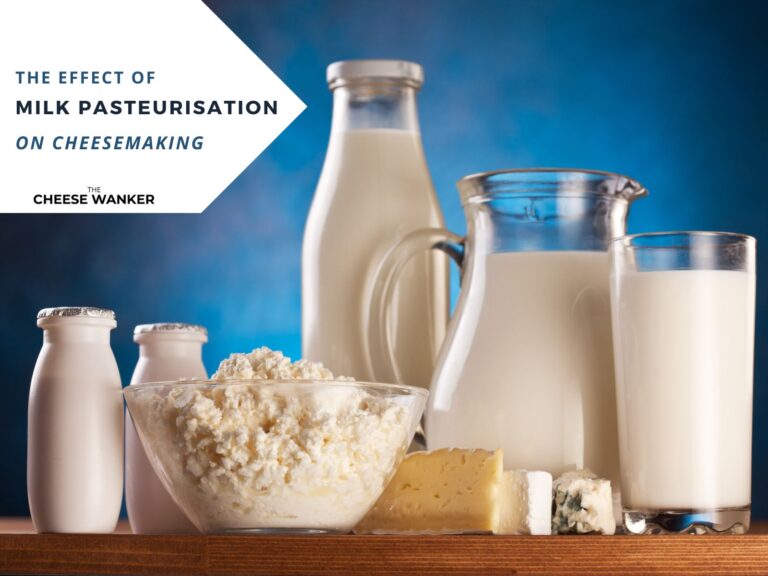In the world of cheesemaking, pH levels play a significant role in shaping both the texture and flavour profiles of our beloved cheeses. As we embark on this scientific journey, we will explore the fundamental aspects of pH and its impact on the art of cheesemaking. Join me as we unravel the intricate relationship between pH and the organoleptic properties of cheese.

SEE ALSO: The essential ingredients you need to make cheese →
What is pH?
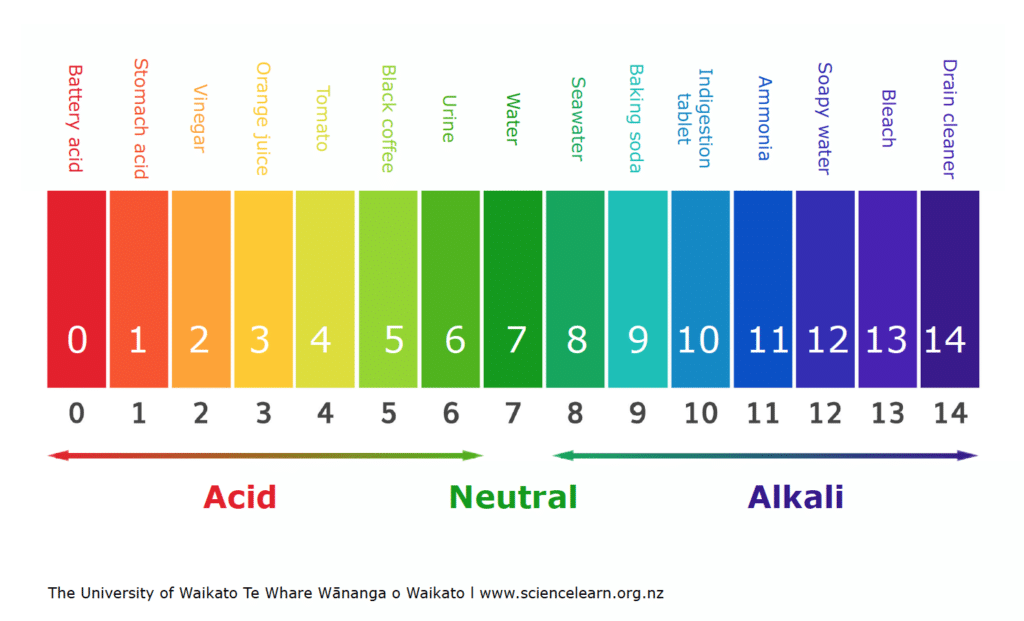
Before delving into the specifics, let’s establish a common understanding of pH. pH is a measure of the acidity or alkalinity of a substance, determined by the concentration of hydrogen ions. It is represented on a scale ranging from 0 to 14, with 7 being neutral, values below 7 indicating acidity, and values above 7 indicating alkalinity.
From milk to cheese
The process of converting milk into cheese involves significant changes in pH. Initially, milk has a pH around 6.5 to 6.7, which is slightly acidic. However, during the cheesemaking process, the pH undergoes several transformations.
In general, cheese is more acidic (lower pH) than milk. And this has a positive impact on several characteristics in cheese, including food safety, texture and flavour. We’ll take a closer look at each one of those further down.
Factors that affect the pH of cheese
The pH of cheese is influenced by various factors throughout the cheesemaking and ageing processes. Understanding these factors is essential for cheesemakers and affineurs to achieve the desired pH range.
And this in turn affects the safety, texture and flavour of the cheese. Let’s explore the key factors that can impact the pH of cheese.
Milk composition (cheesemaking)
It all starts with milk, right? Unsurprisingly, the composition of the milk used in cheesemaking can impact the initial pH of the cheese. Factors such as the breed of the animal, stage of lactation and feed can influence the natural pH of milk.
Milk with a higher natural pH will likely result in a higher starting pH in the cheese. Cheesemakers may adjust the milk’s pH if necessary to ensure consistency and achieve the desired final pH range.
Starter culture (cheesemaking)
Starter cultures play a fundamental role in cheesemaking as they initiate fermentation and contribute to flavour development. Different strains of lactic acid bacteria have varying acid-producing capabilities and pH preferences.
The selection and combination of starter cultures can significantly influence the pH of the cheese. For example, using cultures with high acid-producing abilities can lead to a lower pH, resulting in a tangier cheese.
Acidification techniques (cheesemaking)
Cheesemakers employ different acidification techniques to control the pH of the cheese. This can include the addition of specific acidifying agents, such as lactic acid or citric acid, to adjust the pH during cheesemaking.
Acidification techniques are particularly important when aiming for cheeses with specific characteristics, as they allow for precise control over the pH development.
Maturation conditions (cheese affinage)
The environmental conditions during cheese ripening and ageing can affect the pH of the cheese. Temperature and humidity play crucial roles in microbial activity and enzymatic reactions, which can influence pH changes.
Different bacteria and moulds thrive under specific conditions, and their metabolic processes can impact the production of acids and the pH development of the cheese.
Time and ageing (cheese affinage)
Finally, the duration of ageing is another factor that affects the pH of cheese. During ageing, various biochemical and microbial processes continue to take place, leading to ongoing acid production and proteolysis (breaking down proteins in milk).
The pH of the cheese can gradually change over time due to the cumulative effect of these processes. Different cheese varieties have specific ageing periods to achieve their desired pH ranges and flavour profiles.
Role of pH in cheese safety
The pH level of cheese plays a critical role in determining the growth and survival of pathogens. Pathogens like Salmonella, Listeria and E. coli require a neutral or slightly alkaline pH environment to thrive and reproduce. As a result, cheese with a pH level below 4.5 is considered relatively safe from pathogen proliferation¹.
Conversely, cheese with a higher pH level, approaching 5.5, provides a more favourable environment for pathogen growth. For instance, blue cheese typically contains Staphylococcus equorum and Enterococcus durans in its rind due to the higher pH level, which allows bacteria to flourish and multiply rapidly¹.
Moreover, some pathogens exhibit greater tolerance to acidic conditions and can survive in cheese with a lower pH level.
To ensure the cheese remains within the safe range, it is crucial to diligently monitor its pH level. Furthermore, cheese that undergoes extended ageing naturally becomes more acidic over time, rendering it less hospitable to pathogens.
Impact of pH on cheese texture
Without a doubt, pH significantly affects the texture of cheese. Indeed, the interaction between pH and enzymes during the cheesemaking process plays a crucial role in curd formation and moisture retention, ultimately shaping the final texture of the cheese.
Enzymes like rennet and starter culture are responsible for breaking down proteins in milk and facilitating curd formation. Since pH levels directly impact the activity of these enzymes and cultures, they influence the firmness, elasticity and structure of the curd.
Let’s explore how pH affects the texture of cheese in more detail.
Curd formation (cheesemaking)
During the cheesemaking process, rennet is added to the milk to initiate curd formation. Rennet enzymes, such as chymosin, work optimally within specific pH ranges. The optimal pH level for rennet coagulation is approximately 6.0¹.
When the pH of the milk is too low, it accelerates the rennet coagulation process, leading to a firm and rubbery texture in the final product. Conversely, if the pH is too high, it hinders or delays the rennet coagulation, resulting in a soft and slimy texture, or even preventing coagulation altogether.
Moisture retention (cheesemaking)
The ability of cheese to retain moisture directly impacts its texture. pH levels influence the extent to which curds expel whey, affecting the moisture content and resulting in variations in texture. A lower pH leads to increased whey expulsion (syneresis) and a lower moisture content in the cheese.
As a result, cheeses with lower pH levels tend to have a drier and more crumbly texture. Conversely, higher pH levels can contribute to softer and moister cheeses due to reduced syneresis.
Calcium levels (cheesemaking)
During the acidification of cheese curd, hydrogen ions replace the calcium ions. Hence, the lower the pH, the lower the calcium content will be in the cheese.
Calcium acts as an adhesive agent in cheese, contributing to its elasticity. Consequently, cheeses containing higher levels of calcium exhibit greater elasticity compared to those with lower calcium content (crumbly).
Combined with a low moisture content, the low Calcium content in an acidic cheese like Feta means that its texture is very crumbly. Contrarily, Mozzarella is more neutral in pH (less acidic). Due to this, it has a slightly higher moisture content and a more elastic texture.
Proteolysis (cheese affinage)
Proteolysis, the breakdown of proteins in cheese, is another critical factor influencing texture development. pH levels affect the activity of enzymes responsible for protein breakdown, such as proteases.
As pH changes during the affinage process, these enzymes become more or less active, leading to variations in the breakdown of proteins. The breakdown of proteins impacts the texture by influencing the size and distribution of protein aggregates, contributing to the cheese’s overall structure.
It’s worth noting that different cheese varieties have specific pH requirements to achieve their desired textures. For example, hard cheeses like Parmigiano Reggiano or Cheddar typically require lower pH levels during the cheesemaking process to achieve a firm and compact texture.
Soft cheeses like Brie or Camembert, on the other hand, have higher pH levels, resulting in a soft and creamy texture. We’ll take a closer look at individual cheeses a bit later.
How pH affects the flavour of cheese
In addition to its influence on texture, pH also plays a crucial role in shaping the flavour profile of cheese. The molecular changes that occur due to variations in pH affect acid production, breakdown of proteins and the development of complex flavour compounds.
Let’s delve into how pH impacts the flavour of cheese in more detail.
Acid production (cheesemaking)
pH levels have a direct impact on acid production during the cheesemaking process. Starter cultures, composed of lactic acid bacteria, convert lactose (milk sugar) into lactic acid through fermentation.
The pH of the cheese environment affects the activity of these bacteria. Lower pH levels promote increased acid production, resulting in tangier and more acidic flavours. Cheeses with higher pH levels tend to have milder, less acidic flavours.
Salt uptake (cheesemaking)
When the pH levels of cheese are low, it leads to an increase in the uptake of salt, resulting in a saltier taste. Conversely, higher pH levels in cheese lead to a reduction in salt uptake, leading to a less salty flavour.
The impact of pH on salt uptake in cheese stems from the interaction between salt and the protein molecules present. Salt ions are attracted to the negatively charged protein molecules, causing the proteins to compact. This compaction increases the density of the cheese, resulting in a saltier taste.
However, when the pH levels of cheese are high, the protein molecules carry less negative charge, causing repulsion between the salt ions and proteins. This repulsion leads to a decrease in salt uptake, resulting in a less salty taste.
Rate of proteolysis (cheese affinage)
Proteolysis, the breakdown of proteins in cheese, is influenced by pH and contributes to the development of flavour. Various enzymes, including proteases, break down proteins into smaller peptides and amino acids. pH levels affect the activity of these enzymes, influencing the rate and extent of proteolysis.
As pH rises during the ageing process, proteolysis occurs at a slower rate⁶, leading to the formation of different flavour compounds.
Solubility of flavour components (cheese affinage)
pH levels influence the interaction of various flavour components in cheese, resulting in unique taste profiles. As the pH changes, the solubility and volatility of different flavour compounds are altered.
This affects the perception of flavours, such as sweetness, saltiness, bitterness and umami. The balance and intensity of these flavours are modulated by pH, contributing to the overall taste experience of the cheese.
Formation of aromatic compounds (cheese affinage)
The breakdown of proteins and the metabolism of bacteria during cheese affinage contribute to the development of volatile flavour compounds that craft the cheese’s aroma.
pH levels influence the enzymatic reactions and microbial activity responsible for the formation of these aroma compounds. Furthermore, changes in pH can promote the production of specific aroma compounds, leading to distinctive smells and aromas in different cheese varieties.
It is important to note that pH alone does not determine the entire flavour profile of cheese. Factors such as the type of milk, microbial activity, ageing conditions and duration also influence flavour development. However, pH serves as a critical parameter that interacts with these factors to shape the overall flavour characteristics of cheese.
How to monitor pH levels during cheesemaking
Monitoring pH levels is crucial in cheesemaking to ensure the desired outcomes in terms of texture, flavour and safety. By regularly assessing and adjusting pH throughout the cheesemaking process, cheesemakers can maintain control over the development of the cheese.
Some pieces of equipment that can be used to monitor pH levels include pH meters, data loggers, pH test strips and paper. The last two examples are less accurate and are not typically used at a commercial level.
By monitoring pH levels throughout the cheesemaking process, cheesemakers can make informed decisions regarding the addition of acidifying cultures, adjusting ripening conditions, or taking corrective actions to maintain the desired pH range. This enables them to consistently produce high-quality cheeses with the desired texture, flavour and safety characteristics.
pH levels in famous cheeses
Let’s explore the pH levels of 10 renowned cheeses from around the world and their connection to texture and flavour. By examining the pH values of each cheese, we can understand how they contribute to the unique characteristics of these celebrated varieties.
Parmigiano Reggiano (pH 5.2 – 5.4)²
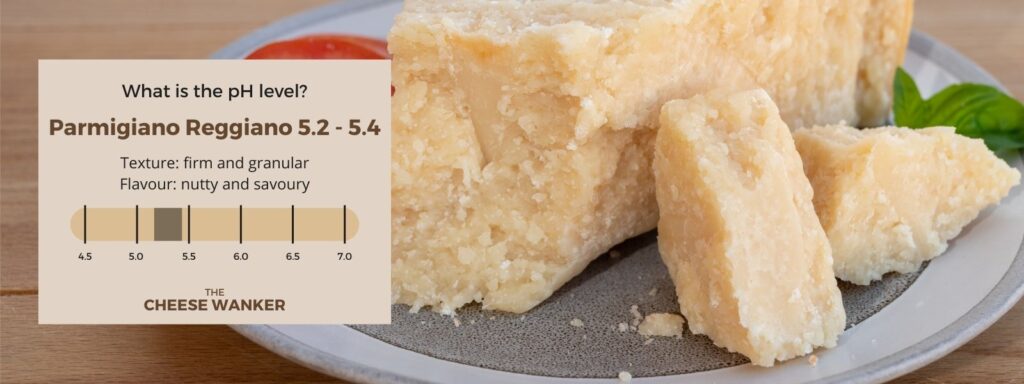
We start our exploration with the King of Italian cheeses. Parmigiano Reggiano, with its slightly acidic pH, has a firm and granular texture. The ageing process contributes to its characteristic crystalline texture. Moreover, the acidic pH level enhances the development of rich, nutty and savoury flavours in Parmigiano Reggiano.
As Parmigiano Reggiano ages, its pH peaks at 5.40 at 24 months and subsequently drops to 5.22 at around 54 months².
Cheddar (pH 5.1 – 5.4)¹

Next, let’s take a look at the world’s most popular cheese. Cheddar, known for its versatility, exhibits a smooth and firm texture. In fact, its pH range contributes to a pliable consistency, allowing it to be sliced, grated or melted with ease.
Moreover, the pH of Cheddar impacts its well-rounded flavour profile. Indeed, the acidic pH adds a tangy note that complements the distinct savoury taste of aged Cheddar.
Brie (pH 6.2 – 6.5)¹

Brie, with its higher pH, boasts a soft and creamy texture. The pH level influences the supple and gooey consistency that makes Brie so luscious and spreadable. Since Brie is a surface-ripened cheese, it is quite common for its texture to range from creamy (higher pH) under the rind to slightly chalky (lower pH) in the centre.
The neutral pH of Brie contributes to its mild and buttery flavour. Actually, the subtle taste of Brie is often accompanied by earthy and mushroom-like undertones.
Camembert (pH 4.5 – 7.0)³

As Camembert ages (15 to 35 days), its pH rises from the surface to the centre. As a result, an aged Camembert tends to exhibit a pH of 7.0 near the rind and 5.0 in its centre. Consequently, most versions of this cheese are soft and creamy under the rind, and a little bit chalky and crumbly in the middle.
As the pH becomes more neutral, Camembert also produces more ammonia. As you can imagine, this volatile compound plays a significant role in the cheese’s aroma. In fact, an overripe Camembert will produce excessive amounts of ammonia which will create a quite unpleasant odour.
Gorgonzola Piccante (pH 5.4 – 6.6)⁴

Next, we have the first blue cheese on our list. Italy’s Gorgonzola exists in two main varieties, a young Dolce and a more mature Piccante. In this post, we are looking at the more mature Piccante.
As Gorgonzola Piccante ages, its pH gradually increases to 6.1 at 50 days and 6.6 at 70 days⁴. The end result is a blue cheese that strikes a balance between softness and firmness.
In addition to this, the moderate acidity of Gorgonzola contributes to its spicy and tangy flavour. And the characteristic blue mould contributes to a complex and robust taste.
Fresh Mozzarella (pH 5.5 – 5.7)¹
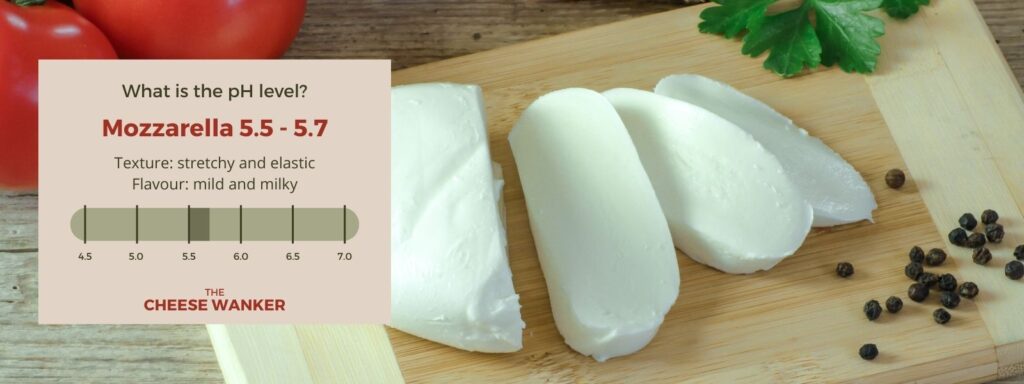
Let’s talk about America’s favourite cheese, Mozzarella! Thanks to its pH, Mozzarella has a stretchy and elastic texture. It melts beautifully and is often prized for its ability to form stringy cheese pulls.
The slightly acidic pH level of Mozzarella imparts a subtle tanginess that balances its mild and milky flavour.
Feta (pH 4.6 – 4.9)¹
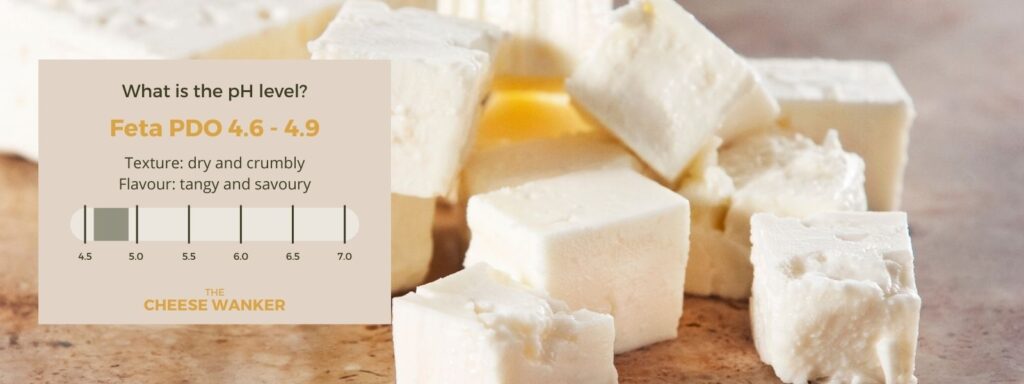
Feta, with its crumbly and dry texture, owes its characteristics to its lower pH level. The acidity contributes to the cheese’s ability to retain its shape when heated. As a result, Feta is not a suitable cheese for melting but rather grilling or baking.
Moreover, the acidic pH of Feta imparts a signature savoury and tangy flavour profile to Greece’s most famous cheese.
Gouda (pH 5.3 – 5.5)¹

The Netherlands’s most famous export has a similar pH profile to Cheddar. As a result, its texture tends to be firm and smooth.
Moreover, the pH of Gouda cheese also influences its flavour profile. The slightly acidic pH contributes to a buttery and nutty taste, which becomes more pronounced with ageing.
Ricotta (pH 5.1 – 5.5)¹
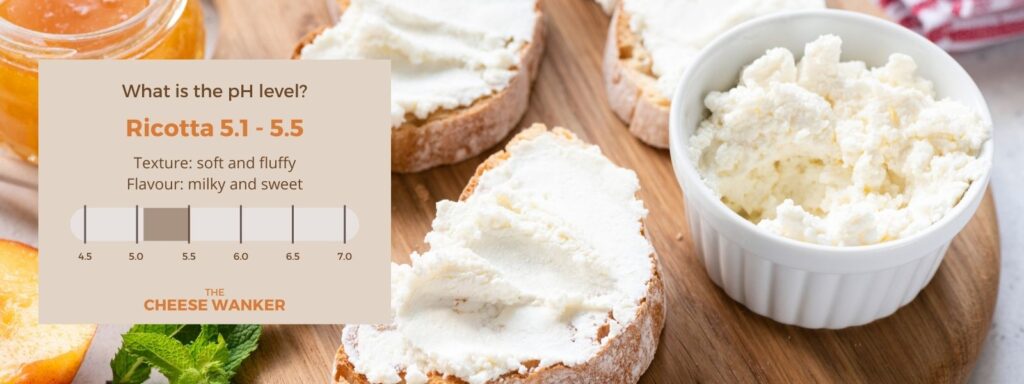
The pH of Ricotta plays a crucial role in its texture, as it affects the coagulation process during cheese production. Ricotta is made by coagulating the whey proteins, and the pH level influences the formation of curds.
The higher pH allows for a looser coagulation, resulting in a soft and delicate texture with small, fluffy curds. This texture is what gives Ricotta its creamy and smooth mouthfeel.
In addition to texture, the pH of Ricotta also influences its flavour. The higher pH level contributes to a milder and slightly sweet taste. Furthermore, the lower acidity associated with a higher pH allows the flavours of the milk to shine through, giving Ricotta a subtle and delicate flavour profile.
Stilton (pH 4.8 – 6.0)⁵
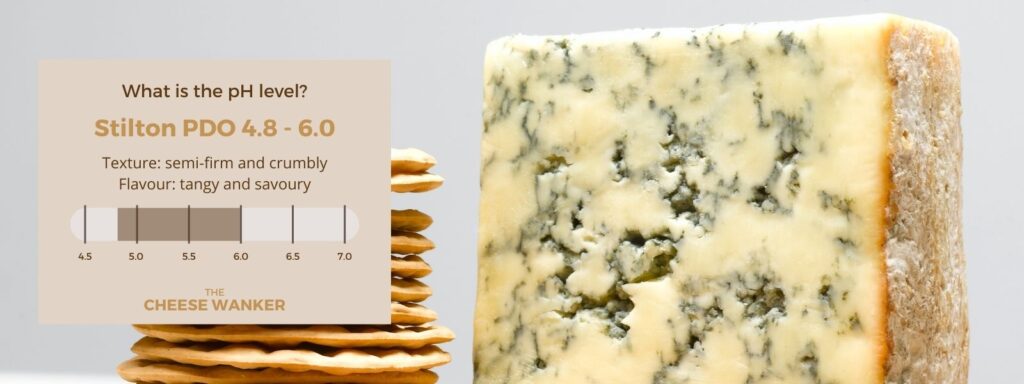
Compared to Gorgonzola, Stilton has a lower pH which gradually rises over the 70 days of ripening. Due to its lower pH, Stilton’s texture is firmer and crumblier than Gorgonzola. Moreover, its flavour tends to be slightly tangier and saltier than its Italian counterpart.
Cheese pH FAQ’s
Here are five frequently asked questions (FAQs) about pH and cheesemaking.
How does pH impact the quality and safety of cheese?
pH plays a crucial role in ensuring the quality and safety of cheese. Maintaining the appropriate pH range during cheesemaking is essential for proper acidification, flavour development, and inhibiting the growth of harmful bacteria. Deviations from the ideal pH can affect the texture, flavour, and shelf life of the cheese.
Can I adjust the pH of cheese during the cheesemaking process?
Yes, cheesemakers have techniques to adjust and control pH levels. They can introduce acidifying cultures or adjust the ripening conditions to influence the development of specific flavours and textures.
Monitoring pH throughout the process allows for adjustments to achieve the desired results.
What happens if the pH of the cheese is too high or too low?
If the pH is too high, it may indicate insufficient acidification, resulting in a less firm texture and a higher risk of spoilage. On the other hand, if the pH is too low, the cheese may become excessively acidic, affecting its flavour, texture, and possibly inhibiting the growth of desirable bacteria.
Maintaining the optimal pH range is crucial for achieving the desired cheese characteristics.
Does the pH of the milk used in cheesemaking affect the final cheese pH?
Yes, the pH of the milk used in cheesemaking can influence the final cheese pH. Factors such as the health of the lactating animal, stage of lactation, and the presence of specific bacteria can affect the initial pH of the milk.
Cheesemakers often test and adjust the milk’s pH to ensure consistency in the cheesemaking process.
How does pH affect the ripening and ageing of cheese?
pH levels have a significant impact on the ripening and ageing processes of cheese. During ageing, the pH gradually changes due to the activity of microorganisms.
The breakdown of proteins and the development of complex flavours are influenced by these pH changes. Monitoring and controlling the pH during ageing help achieve the desired flavour profiles and textures in mature cheeses.
Summary
pH levels hold the key to unlocking the fascinating world of cheesemaking. From texture to flavour, pH influences every aspect of the cheesemaking process, resulting in a vast array of cheese varieties with unique characteristics.
Armed with this scientific knowledge, we can embark on our own cheesemaking adventures, experimenting with pH to create exquisite cheeses. So, embrace the power of pH and embark on your journey to craft exceptional, flavourful cheeses.
Are you a seasoned cheesemaker? We’d love to hear your insight on the importance of monitoring pH levels during cheesemaking. Please leave us a comment below.
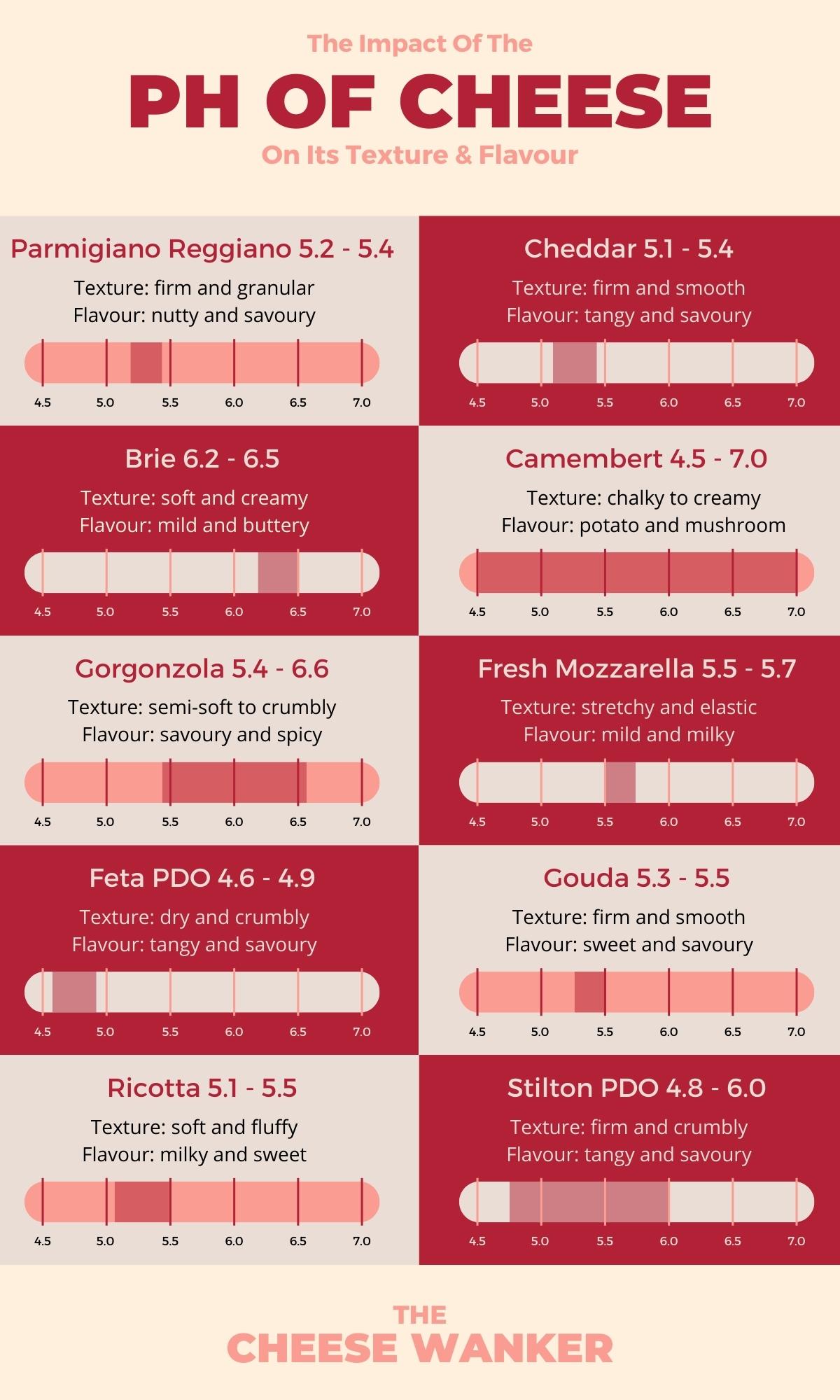
References
¹ The Importance of Measuring the pH of Cheese – Atlas Scientific
² Caratterizzazione chimico-fisica della maturazione del Parmigiano-Reggiano
³ The Chemistry of Camembert – Compound Chem
⁴ The Ripening of Gorgonzola PDO – Italian Foodtech
⁵ Studies on the ripening of stilton cheese: Proteolysis
⁶ Effect of pH and calcium concentration on proteolysis in Mozzarella cheese

